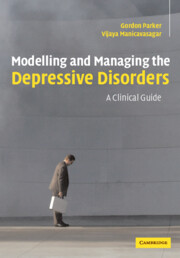Book contents
- Frontmatter
- Contents
- Acknowledgements
- Introduction
- Part I The current model for depressive disorders and its impact on clinical management
- Part II The diagnosis and management of melancholic and psychotic depression
- Part III An introduction to non-melancholic depression
- Part IV Modelling and managing the non-melancholic depressive disorders
- Appendix 1 The DMI-18 and the DMI-10
- Appendix 2 The CORE system of measuring psychomotor disturbance
- Appendix 3 The temperament and personality measure
- References
- Index
Appendix 2 - The CORE system of measuring psychomotor disturbance
Published online by Cambridge University Press: 17 August 2009
- Frontmatter
- Contents
- Acknowledgements
- Introduction
- Part I The current model for depressive disorders and its impact on clinical management
- Part II The diagnosis and management of melancholic and psychotic depression
- Part III An introduction to non-melancholic depression
- Part IV Modelling and managing the non-melancholic depressive disorders
- Appendix 1 The DMI-18 and the DMI-10
- Appendix 2 The CORE system of measuring psychomotor disturbance
- Appendix 3 The temperament and personality measure
- References
- Index
Summary
The CORE was initially developed as a measure of the domains of psychomotor disturbance specific to melancholic and psychotic depressive disorders. A full description of its developmental is provided in Parker and Hadzi-Pavlovic (1996). The final measure comprises 18 signs (observable features) which are rated by the clinician or a trained observer at the end of a clinical interview. Each sign is rated on a 4-point scale (0–3), where a rating of 0 conveys a general concept of normality or the subject's usual behaviour. By contrast, a rating of 2 or 3 always implies definite pathological behaviour. A score of 3 also indicates severe disturbance on that behavioural domain. Sub-sets of items produce scores on each of three dimensions found to underlie psychomotor change: ‘non-interactiveness’, ‘retardation’, and ‘agitation’.
Principal components analysis of the 18 items of the CORE suggested a trunk and branch analogy for construing psychomotor disturbance and for deriving subscales. The six truncal items contribute to a non-interactiveness scale which is thought to reflect disturbances in neurocognitive processing or the psychic component of psychomotor disturbance, which, when severe, can generate a diagnosis of pseudo-dementia in depressed patients. The remaining CORE items on the left- and right-hand ‘branches’ define the motor aspects of psychomotor disturbance, with some specificity to either agitation or to retardation.
- Type
- Chapter
- Information
- Modelling and Managing the Depressive DisordersA Clinical Guide, pp. 226 - 227Publisher: Cambridge University PressPrint publication year: 2005



